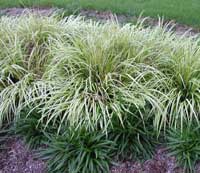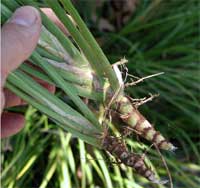Resource Library
Plant of the Week: Sweet Flag, Japanese
The University of Arkansas System Division of Agriculture does not promote, support or recommend plants featured in "Plant of the Week." Please consult your local Extension office for plants suitable for your region.
Plant of the Week
Japanese Sweet Flag
Latin: Acorus gramineus

The more I know about a plant, the more I appreciate it. The Japanese sweet flag (Acorus gramineus) is becoming more common in our gardens, but its’ small stature doesn’t necessarily indicate the importance it may have played in the evolutionary history of the world.
Japanese sweet flag is a small grass-like herbaceous perennial that spreads by means of a shallow, much-branched rhizome. From these rhizomes are produced a number of narrow, glossy, foot-long leaves arrayed at the ends of the rhizomes in a fan-like fashion. The leaves resemble those of some irises. It’s native in a wide swath from India to the Philippines, but most of the forms in cultivation are selections made by Japanese gardeners.
A number of cultivars are available, each with distinctive growth forms. ‘Ogon’ is a golden-leafed form with leaves about a foot long and is currently most common in nurseries. ‘Variegatus’ has a creamy yellow stripe down the length of the blade. ‘Pusillus’ is a dwarf, 3-inch tall clumping form; ‘Minimus Aureus’ is a golden foliaged dwarf. These last two are too small to use in the average garden because they would be overrun by more vigorous plants.
Acorus flowers are a curiosity in themselves. In early spring, a white, finger-like flower is pushed out of the side of a normal looking leaf about half way along its length. The floral spike (spadix) is about 2-inches long and resembles that of the philodendron family, where Acorus has been traditionally placed.
But Acorus always seemed to be an odd fit in the philodendron tribe, so in 1987 it was finally moved from that family to one of its own, the Acoraceae. Plant reclassification has been rampant in recent years, partly because of increased international collaboration between botanists and partly because DNA analysis has become a powerful new tool to aid in the understanding of botanical relationships.

Using DNA typing, scientists looked at a number of marker genes in Acorus and tried to match it in a DNA database. The more matches, the more closely the plants are related. Acorus DNA didn’t match well with the philodendron family nor any of the other monocots, but it did match somewhat with members of the pepper family, a dicot.
Some scientists now think that Acorus may be the first monocot - plants that produce only one seed leaf at germination and include grasses, palms, orchids, philodendrons, bromeliads and the like. Evolutionarily speaking, monocots are more modern than dicots, plants producing two seed leaves at germination and the largest overall group of flowering plants. So, this lowly little plant may have had earth-changing biological significance, being an ancient ancestor to the most important of our world food crops.
Japanese sweet flag has long been grown as a houseplant but, since water gardening returned to fashion, it has been touted as a aquatic plant for use in shallow pools. We now realize it is hardy outside throughout Arkansas and as far north as zone 5 in just average garden soils. It grows in full sun or moderate shade.
Because of its aquatic heritage, it will grow in heavy clay soils, but does best in fertile, reasonably moist locations. It’s evergreen throughout the state, but leaf tips may burn during periods of extreme cold or if the plants get bone dry in the summer. Propagation is easy by division at any time of the year. I have seen no indication of pests or diseases.
By: Gerald Klingaman, retired
Extension Horticulturist - Ornamentals
Extension News - April 21, 2006
The University of Arkansas System Division of Agriculture does not maintain lists of retail outlets where these plants can be purchased. Please check your local nursery or other retail outlets to ask about the availability of these plants for your growing area.